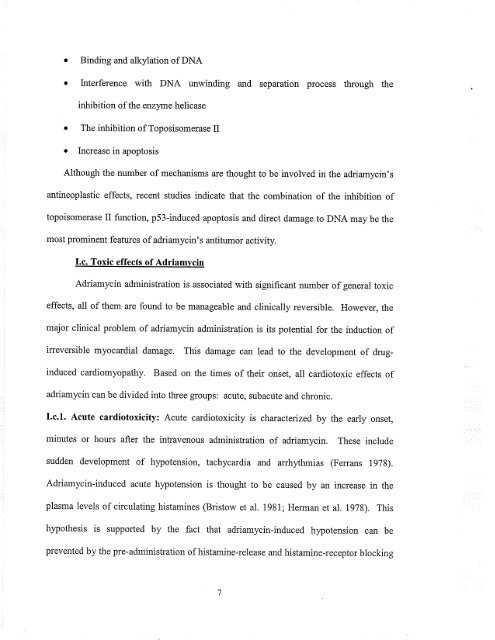il\VOLVEMENT OF RETII\OIC ACID II{ - MSpace at the University of ...
il\VOLVEMENT OF RETII\OIC ACID II{ - MSpace at the University of ...
il\VOLVEMENT OF RETII\OIC ACID II{ - MSpace at the University of ...
Create successful ePaper yourself
Turn your PDF publications into a flip-book with our unique Google optimized e-Paper software.
Binding and alkyl<strong>at</strong>ion <strong>of</strong> DNA<br />
Interference with DNA unwinding and separ<strong>at</strong>ion process through <strong>the</strong><br />
inhibition <strong>of</strong> <strong>the</strong> enzyme helicase<br />
The inhibition <strong>of</strong> Toposisomerase <strong>II</strong><br />
o Increase in apoptosis<br />
Although <strong>the</strong> number <strong>of</strong> mechanisms are thought to be involved in <strong>the</strong> adriamycin's<br />
antineoplastic effects, recent studies indic<strong>at</strong>e th<strong>at</strong> <strong>the</strong> combin<strong>at</strong>ion <strong>of</strong> <strong>the</strong> inhibition <strong>of</strong><br />
topoisomerase <strong>II</strong> function, p53-induced apoptosis and direct damage to DNA may be <strong>the</strong><br />
most prominent fe<strong>at</strong>ures <strong>of</strong> adriamycin's antitumor activity.<br />
I.c. Toxic effects <strong>of</strong> Adriamvcin<br />
Adriamycin administr<strong>at</strong>ion is associ<strong>at</strong>ed with significant number <strong>of</strong> general toxic<br />
effects, all <strong>of</strong> <strong>the</strong>m are found to be manageable and clinically reversible. However, <strong>the</strong><br />
major clinical problem <strong>of</strong> adriamycin administr<strong>at</strong>ion is its potential for <strong>the</strong> induction <strong>of</strong><br />
irreversible myocardial damage. This damage can lead to <strong>the</strong> development <strong>of</strong> druginduced<br />
cardiomyop<strong>at</strong>hy. Based on <strong>the</strong> times <strong>of</strong> <strong>the</strong>ir onset, all cardiotoxic effects <strong>of</strong><br />
adriamycin can be divided into three groups: acute, subacute and chronic.<br />
I.c.l. Acute cardiotoxicity: Acute cardiotoxicity is characteized by <strong>the</strong> early onset,<br />
minutes or hours after <strong>the</strong> intravenous administr<strong>at</strong>ion <strong>of</strong> adriamycin. These include<br />
sudden developrnent <strong>of</strong> hypotension, tachycardia and arrhythmias (Ferrans lg78).<br />
Adriamycin-induced acute hypotension is thought to be caused by an increase in <strong>the</strong><br />
plasma levels <strong>of</strong> circul<strong>at</strong>ing histamines (Bristow et al. 1981; Herman et al. 1978). This<br />
hypo<strong>the</strong>sis is supported by <strong>the</strong> fact th<strong>at</strong> adriamycin-induced hypotension can be<br />
prevented by <strong>the</strong> pre-administr<strong>at</strong>ion <strong>of</strong> histamine-release and histamine-receptor blocking







![an unusual bacterial isolate from in partial fulf]lment for the ... - MSpace](https://img.yumpu.com/21942008/1/190x245/an-unusual-bacterial-isolate-from-in-partial-fulflment-for-the-mspace.jpg?quality=85)





![in partial fulfil]ment of the - MSpace - University of Manitoba](https://img.yumpu.com/21941988/1/190x245/in-partial-fulfilment-of-the-mspace-university-of-manitoba.jpg?quality=85)


